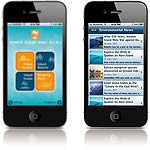It’s an adventure of a lifetime for a New Zealand couple and their young children as they make a home on Stephens Island, a conservation haven where thousands of prehistoric reptiles roam.
Found at the northern head of the Marlborough Sounds, the remote outpost of Stephens Island may just be real-life answer to Jurassic Park. The 150-hectare island, encircled in forbiddingly steep cliffs and swathed in dark green foliage, certainly resembles a land that time forgot – and for one of the island’s creatures, it was forgotten a very long time ago indeed. Approximately 60 million years, in fact, when all similar species vanished, but the scaly, spiny, lizard-like tuatara endured.
At least, it endured until European settlers landed in New Zealand, when the tuatara became a threatened species. In addition to being a rare throwback in the geological timescale, the tuatara are also known for their remarkably long life spans, which, according to some researchers, could exceed 200 years. At the zoo in Invercargill, on the South Island, a male tuatara named Henry is still active and breeding at more than 110 years old.
Now extinct in the wild on the mainland, Stephens Island is one of the few remaining homes of this unusual reptile, which flourished in New Zealand hundreds of millions of years ago and trod the same primeval earth as the heavily-armoured Anklyosaur and mammoth, 100-ton Titanosaur. According to some estimates, as many as 50,000 tuatara make Stephens Island home – by far the largest concentration of the animals anywhere in the world.
The story of New Zealand is much like that of Australia, Hawaii, or the Galapagos Islands; a tale of a devastated ecology pulled back from the brink by the determination of countless conservationists. All of these places were once home to a thriving assortment of native species, but European-introduced predators like cats, goats, and weasels ravaged their unsuspecting new environment, making short work of indigenous animals that lacked the awareness or protection to defend against them.
Stephens Island has been an imported target for New Zealand’s Department on Conservation (DOC) for many years, not just for the prehistoric tuatara, but other endangered species like Hamilton’s frog, the rarest frog on the planet, and a wide assortment of seabirds, lizards, and insects. As a living time capsule, the island requires the utmost care, and that’s where one daring family from near Wellington comes in. Frank Higgott, Sue Caldwell, and their young children Piripi and Heeni have made the brave move to become the Stephens Island DOC rangers, and live on the island full-time for three years.
Here, the couple will live in the old lighthouse keeper’s house and will spend their days looking after the tuatara, protecting the Hamilton’s frogs from predators, plant and restore endemic foliage, and take care of general maintenance of the island’s buildings. The children, 5 and 3 years of age, have already adjusted to island life – they grew up on nearby Mana Island, and even lived for a spell on the family yacht. However, making a go of it on a remote island is never an easy one, and on Stephens, there are plenty of challenges to keep the family on their toes.
Powerful winds – rumoured to have once carried off the cow of a lighthouse keeper – blast across the island during storms, making even a brief walk from one building to another a hazardous journey. With no utility connection to the mainland, the family will be using rainwater to survive, hoping to avoid the droughts suffered by the last ranger, Tim Bacon. And most of all, there will be the isolation; as a protected area, no day-trippers are allowed on Stephens, and the only visitors will those with permits issued by the DOC.
The family has been preparing for life on Stephens, however, and even, according to Frank Higgot, eagerly awaiting its challenges. “You’re slotted into survival mode to a certain extent,” he told the Marlborough Express newspaper in a recent interview. “It’s a good chance for us to instil some things into our children. It’s more about living without and surviving without and making do. That’s one part of the whole experience we’re really looking forward to.”
Read more about this story: Marlborough Express News





